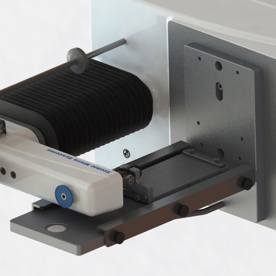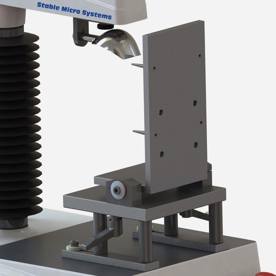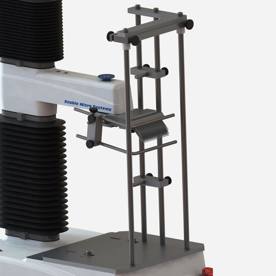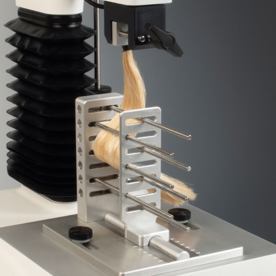Other test types
Learn about additional testing options, when to use these test types and the typical probes and attachments for use on a Texture Analyser.




There are a range of additional texture test types that measure specialist material behaviours such as friction, abrasion, disintegration, scoopability, and combability. Using customised attachments and programmable sequences in Exponent Connect software, a Texture Analyser can replicate consumer handling or mechanical stress, providing quantitative data beyond standard compression or tension tests. These tests are particularly valuable when you need to mimic consumer use or assess product handling behaviour.
Using Exponent Connect software, operators can sequence actions or reorient the instrument to perform non-vertical motions, such as horizontal friction measurement or dynamic multi-stage actions. This flexibility allows Stable Micro Systems instruments to measure almost any mechanical characteristic relevant to product performance.
Common additional properties measured
Friction and slip resistance
Using the Horizontal Friction System or Friction Rig, surface friction between materials – such as film-on-film, packaging layers, or coated tablets – can be quantified. Data includes static and dynamic friction coefficients, useful for packaging design or lubricity studies.
Abrasion and wear
The Abrasion Test Rig measures resistance to surface wear or roughness, ideal for coatings, food crusts, or cosmetic films. This helps quantify durability and surface integrity.
Disintegration
With the Tablet Disintegration Rig, the time or force required for a solid dosage form or structured product to break apart is measured. This is particularly relevant in pharmaceutical and nutraceutical applications.
Scoopability
Fixtures such as the Ice Cream Scoop Rig or Bread V Squeeze Rig assess the force required to scoop, spread or extract semi-solids, providing insight into consumer usability and temperature effects.
Combability and Suppleness
The Hair Combing Rig and Hair Suppleness Rig measure the ease with which fibres or strands pass through a comb or deform under bending stress, supporting formulation optimisation in personal care and cosmetics products.
Examples of unusual tests that can be performed on a Texture Analyser
Example probes and attachments
|
Property |
Attachment example |
Typical application |
|
Friction |
Horizontal Friction System |
Film-on-film testing, tablet coating |
|
Abrasion |
Abrasion Test Rig |
Coating wear, surface roughness |
|
Disintegration |
Tablet Disintegration Rig |
Pharma dosage forms |
|
Scoopability |
Ice Cream Scoop, Bread V Squeeze Rig |
Ice cream, spreads, dough |
|
Combability |
Hair Combing Rig, Hair Suppleness Rig |
Haircare, fibre materials |
Creating custom test solutions
Use these methods when conventional compression or tension tests do not represent the real-world behaviour of your product. They are ideal for:
- Simulating consumer handling or sensory interaction
- Quantifying wear or fatigue properties
- Measuring usability characteristics (scoopability, combability)
- Evaluating frictional behaviour in packaging or coatings
Example standard methods for friction testing
ASTM D1894 – Comparison of stiction and friction of two packaging sheet types using a Friction Rig.
People also ask
What are “other” test types in texture analysis?
These refer to non-standard or specialist tests-such as friction, abrasion, or disintegration-carried out using a Texture Analyser and tailored fixtures to simulate real product use.
How is friction measured on a Texture Analyser?
By using a Horizontal Friction System or Friction Rig to move two surfaces relative to each other under controlled load, measuring static and dynamic friction coefficients.
Can Texture Analysers perform abrasion tests?
Yes. The Abrasion Test Rig quantifies surface wear or durability, commonly applied to coatings, films, and solid foods.
What is scoopability in texture analysis?
Scoopability measures the force required to extract or scoop a semi-solid product such as ice cream or spread, reflecting consumer ease-of-use.
Can custom attachments be designed for unique materials?
Yes. Stable Micro Systems designs bespoke attachments to simulate specific motions or product interactions when standard attachments are not suitable.








